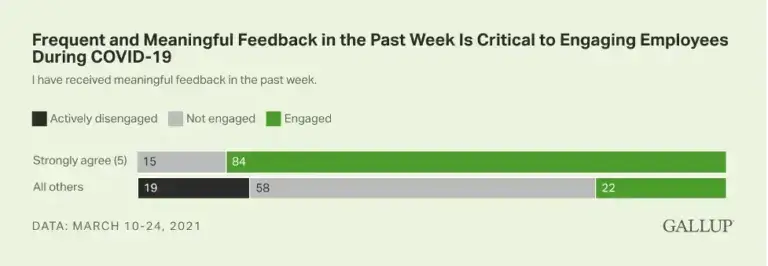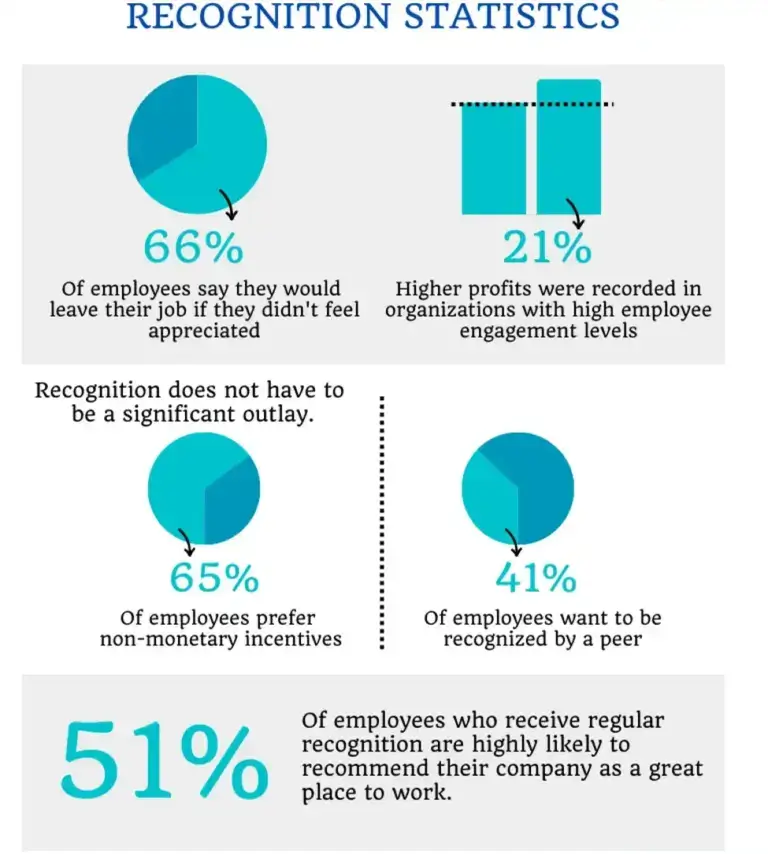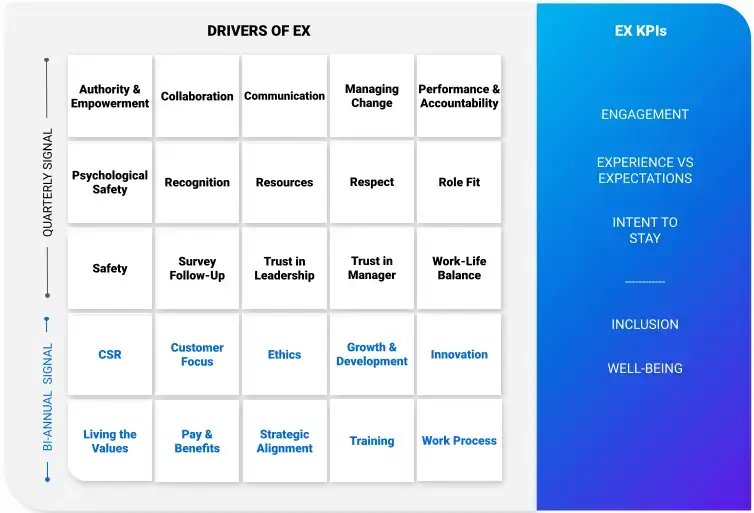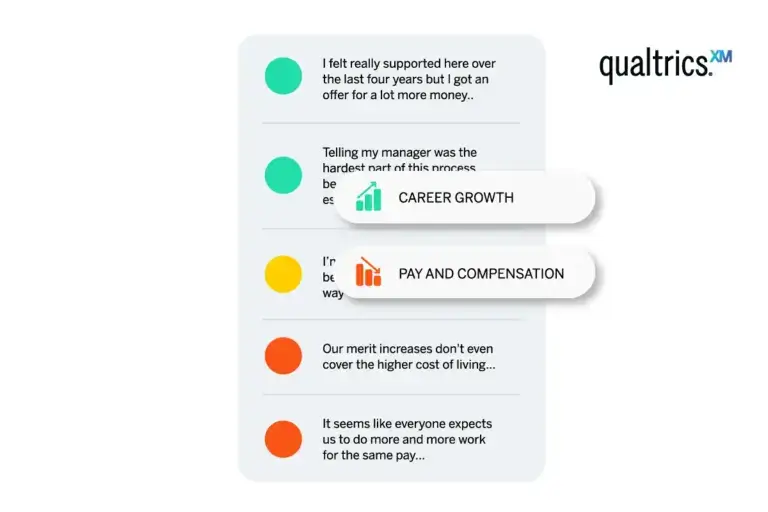Learn how real-time feedback can improve performance, employee experience, customer satisfaction – and ultimately drive the growth of your business. Harness the power of pulse surveys and continuous listening, and never miss a thing.
Part of performance management, real-time feedback is an ongoing process where team leaders communicate feedback to employees as soon as situations arise, rather than waiting to review it at a later date. Through real-time feedback, organizations, leaders and managers can provide accurate, relevant and timely insights to their people.
The world of work has rarely been as tumultuous, challenging and pressured as it has been during the last five years. From the work from home (WFH) / work from anywhere (WFA) movement and the Covid-19 pandemic, to Great Resignation, the rise of hybrid working, and the march of AI, organizations have been hard pushed to get priorities right when it comes to their people.
Every HR leader knows that making the right decisions for the workforce requires deep and powerful contextual insights. Where are the challenges? What are the blockers? How do our people feel? These are just a few of the questions that HR teams
The reality is that the traditional way of capturing feedback doesn’t work for today’s fast-paced world. Annual performance reviews or annual engagement surveys are only a snapshot in time — even quarterly surveys aren’t frequent enough.
And what about the ‘moments between moments’? Those occasions when you’ve introduced a new WFH policy perhaps, or maybe have some unwelcome news to deliver to the wider organization? How do you measure employee sentiment about those moments to get a clear signal about what you need to do next?
The most useful solution to understanding what your workforce thinks and feels is through real-time feedback. Real-time feedback lets you get to the heart of what your employees care about, right when you need to know.
Amid the smoke of the current business climate, real-time feedback is your signal fire, pinpointing what’s going on where, and giving you data that you can act on immediately. The vast majority of HR leaders are moving towards a culture of more frequent feedback – you need to join them.
Discover the power of real-time feedback for HR leaders & teams
What is real-time feedback?
Real-time feedback is part of performance management. It’s an ongoing process, with team leaders communicating feedback to employees as soon as situations arise, rather than waiting to review it at a later date. Real-time feedback is therefore accurate, relevant and timely.
By giving instant feedback on performance, outcomes or even behaviors, managers can help employees correct mistakes before they grow out of control or are repeated, improve their skills and knowledge, and understand what’s expected of them.
Real time, continuous feedback can be immensely helpful in the following scenarios:
- Acknowledging a job done well and ahead of schedule
- Solving a problem that a team member has been struggling with
- Pointing out an error or missed deadline
- A customer or client is unhappy with the goods or services they’ve received
- Technology isn’t working as it should be
- Resources to get the job done are lacking
- Concluding a brainstorming meeting with appreciation of the team’s well-thought-out ideas and contributions
What are the benefits of real-time feedback?
‘Strike while the iron is hot’ is an old blacksmithing adage, but it sums up the concept of real-time feedback perfectly – decisively grab an opportunity to act before it’s too late. The benefits of not letting that iron cool are:
A deep understanding of your employee experience
Engaged employees are the mainstay of a successful organization, and you want them to stay that way. Meaningful feedback is powerful: research from Gallup found that when employees ‘strongly agreed’ they received ‘meaningful feedback’ in a previous week, they were almost four times more likely than other employees to be engaged.

Image from gallup.com
Increased employee performance
It’s no surprise that feedback improves employee performance. After all, job training consists of trying out skills and knowledge, making mistakes, having them corrected, and learning from the experience. Real-time feedback flags up issues as soon as they happen so they can be addressed in good time and everyone can move on doing a great job.
Close gaps there and then
When organizations rely only on the annual performance review – or even quarterly reviews – there are lots of experience gaps that sometimes remain open for a long time. Maybe an employee is trying to manage an unmanageable workload, and is missing deadlines or making mistakes as a result. Leaving that employee to struggle for a quarter – or even a whole year if your managers aren’t getting real-time insights – can cause irreparable damage to the organization, the team and the employee. A real-time feedback process can pick up the first missed deadline or mistake so questions can be raised and solutions found.
Actionable insights
The great thing about real-time feedback is it can pinpoint exactly where and when the problem occurred, so that you can identify the cause and resolve it quickly. And a fresh issue, rather than one that has been festering for a while, is more motivating to jump on and solve. It’s current, and fresh in people’s memories so it doesn’t get forgotten about.
Ensure people are rewarded
Employees want to be recognized for the work they do, and that recognition goes beyond money. According to statistics compiled by SelectSoftware reviews:
- 66% of employees say they would leave their job if they didn’t feel appreciated
- 65% of employees prefer non-monetary incentives
- 51% of employees who receive regular recognition are highly likely to recommend their company as a great place to work

Image from selectsoftwarereviews.com
Real-time feedback offers a great opportunity to give recognition for a job well done, whenever it’s done. A contact center assistant handles an angry caller well and resolves their problem? Immediately praise that assistant. An intern sorts out a software glitch that’s been bugging the whole team? Time for a shout out. Real-time feedback will highlight these moments of triumph so you can recognise your employees accordingly.
Accelerate performance reviews
Real-time feedback can make your performance management processes a lot less painful for everybody. Let’s break it down:
For managers
Instead of having to remember, review and collate 3 to 12 months’ worth of work observation for each team member, managers can use real-time feedback records, with their associated context, to inform the end-of-year reviews. As well as saving time, performance reviews that include real-time feedback avoid recency bias that can distort the overall picture of an employee’s achievements.
For employees
With real-time feedback, annual reviews cease to be anxiety-inducing, or an unpleasant surprise. Throughout the year, an employee’s performance will have been assessed and corrected with constructive feedback, noting good performance and highlighting areas of weakness, so the employee has a good idea of how they have performed. They are unlikely to be broadsided by unexpected critical feedback.
Greater transparency and trust
The regular interactions and conversations that make up real-time feedback strengthens manager-team trust, as it gives managers more opportunity to support their teams. Most real-time feedback software has automatic reminders and incident triggers to keep managers informed.
Teams will also get on better as they will feel more supported knowing that issues are being flagged and guidance is readily accessible – without the need for micromanaging.
Fuels business growth
There’s really no area of business growth that real-time feedback cannot enhance: preventing costly errors, quality control, employee motivation and retention, fostering a positive company culture, customer experience, brand reputation, and much more.
That is, provided you do it right…
Setting up your real-time feedback program
You’re interested in reaping the benefits of real-time feedback, so what do you need?
1. When should you collect real-time feedback?
The golden rule for collecting any sort of feedback is: only when you are able to act on it. It will also depend upon several factors: the nature of your business or organization, organizational goals, and managerial and employee preferences.
There are a few general principles to consider. Feedback should be:
- Frequent enough to provide relevant and timely insights, but not so frequent that it’s overwhelming, disruptive, or causes survey fatigue
- Aligned with the timings of your current business goals
- Customized to the needs and wants of managers and employees – some may want more feedback, some less
2. What kind of metrics and topics should you monitor?
Engagement, as a single metric, is no longer enough to measure employee experience. Instead, you need a more holistic approach — take Qualtrics® EX25, for example. It identifies 5 KPIs to track employee experience, and 25 drivers – those critical topics that impact the KPIs:

3. What questions should you ask?
Questions you ask need to chime with what you want to find out from the feedback, but generally they need to be:
- Open-ended to encourage people to expand on their answers
- Specific to focus on observable impacts and outcomes
- Constructive, to encourage employees to identify strengths, weaknesses and opportunities to improve
- Goal-orientated to help plan for future development
Technology to help your real-time feedback performance management strategy
Pulse surveys
When it comes to real-time feedback, pulse surveys are your best friends. They are shorter and reduce the amount of time it takes employees to give their feedback, and they introduce a new dimension to results analysis: tracking over time.
As long as your pulses have some consistency, you’re able to track the same item over time and see how it changes from one month or quarter to the next as you bring in improvements and solutions.
Regular pulses let you:
- check in (and react) more regularly
- plot trends over time
- start to link improvements back to actions
They can be used to measure absolutely anything that matters to employees and the business, including:
- maintaining an early warning system for important business metrics, e.g. a safety pulse or customer service pulse
- measuring the effectiveness of action plans, particularly those implemented after a traditional engagement survey
- helping to understand the relationships between different types of employee feedback, as well as other important business outcomes that are tracked frequently, such as voice of the customer(VoC), performance, and turnover.
Pulse surveys can be used as often as you like, but you need to ask two questions before you blithely start sending them out every few days:
- How frequently does the organization need to see results from the surveys?
- How quickly can the organization respond to the results?
And as for the question of survey fatigue: the biggest cause of fatigue is not so much survey frequency, it’s poorly managed communication: if employees don’t hear back about their feedback, closing the feedback loop, they tend to lose interest.
Continuous listening
Once upon a time, sending a survey by email was considered cutting edge, and it may be that pulse surveys on their own will seem quaint when seen within the context of developments in continuous listening.
Sentiment analysis tools such as Qualtrics Employee Listening, will help you find out exactly what your people need – even if they don’t tell you. Combing through external forums, social media, and review sites, continuous listening picks up feedback about the organization from employees, candidates, and alumni. You’ll even be able to analyze messaging, calls, chat, and emails to uncover opportunities to improve the customer service experience – and the employee experience too.

But don’t worry – surveys aren’t going away anytime soon. Instead, continuous listening applies Natural Language Understanding (NLU) to open text feedback to gain a detailed understanding of how every employee feels. You can surface hidden topics and know exactly what’s driving employee experience.
Watch demo: Discover the power of real-time feedback for HR leaders & teams